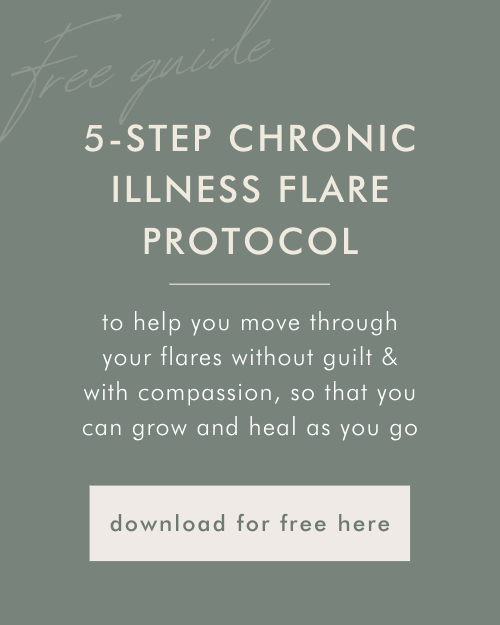5 simple cues that’ll reduce the impact of a chronic illness flare-up
What if you could flare better? So well, in fact, that it results in your flares occurring less frequently, with them being less severe each time.
My 5 Step Chronic Illness Flare Protocol helps you move through chronic illness flare-ups without guilt or shame & with compassion. You get to learn from your flares and grow and heal as you go!
Flares are a part of chronic illness life we all experience from time to time, but they don’t need to be this huge void that sucks the life out of you without giving anything back.
Along with taking care of yourself when you’re flaring, you can use the information your flares give you to not only reduce both the frequency and severity of your flares moving forward, but improve the way you experience your chronic illness overall.
There’s wisdom within flares, just as there’s wisdom within all of chronic illness, and here’s how you tap into it using my 5-step flare protocol. Sign up below to get it!
1) Take a moment to pause and notice what’s going on.
Prep phase no.1. Without taking the time to check-in, the next 4 steps probably won’t happen (because you won’t realise you need them!)
When you feel yourself approaching a chronic illness flare, or when you suspect one might have been triggered by whatever is going on in your life, your immediate response is probably to bury your head in the sand and hope it’ll go away, and to try and pack all the things in before it comes (which inevitably makes it more severe).
That’s a totally understandable response, especially if your experience of flares up until now have been full of misery. BUT, you want to change the way flares show up in your life, right? By working towards them being less severe, less frequent, and being able to learn and grow from them. So it’s really important that you don’t run away from them - or yourself - and learn how to sit with them whilst also putting your nervous system at ease. Which brings me to…
2) Let self-compassion lead the way.
Compassion is very often not the thing that first happens when we flare - if it happens at all. All the self-blame, anxiety, guilt, shame and rejection make no space for it. But what if you lead with compassion?
Leading with compassion makes it more likely that you’ll accept the flare that’s actually happening, or about to happen, and make tweaks to your life to give it the room it needs to breathe and do it’s thing, rather than trying to push it down until it inevitably stops your body dead in its tracks.
Not only that, but why wouldn’t you show yourself compassion - aside, of course, from all the conditioning that’s made you believe you’re somehow to blame?!
*What do you think self-blame, creation, anxiety, guilt, shame and rejection does within your body and to your nervous system? Shocker, all those things will exacerbate the flare either in severity or duration, or both.
(*probably not scientifically proven, just common sense and experience!)
If that’s true, what can be said for compassion?
Want to know what self-compassion looks like for you? Use this protocol journaling guide to help you figure it out.
3) Treat: what can you do in the moment that will help you feel better?
Treat is the first of the 3T’s.
It’s asking; what will help you feel better now?
No denying, this is the plaster/band-aid, but it’s not a plaster without backup. It’s important for you not to suffer; there are no medals for white knuckling through a flare, and the stress of doing so will arguably make the whole experience worse for you.
The ‘treat’ phase will be unique to your needs. It’s a great idea to have a ‘Treat toolbox’ on hand, so that you don’t need to put too much thought into it when you’re flaring and need to conserve energy.
It’s also a GREAT idea to give this toolbox (in the form of a list or quite literally a physical kit) to anyone in your support network, so that they can help you without you having to organise it in the moment.
Your Treat toolbox might include medication, heat/cool pads, or a line up of your go-tos on Netflix, your favourite most comfy pair of PJs, a playlist that makes you feel held and calm, favourite guided meditation or breathwork sessions, a pre-written text asking for the support you need, a frozen meal that nourishes you nutritionally and a stash of chocolate that nourishes your soul…
Honestly, the list of things is endless and there are no rules or limits as to what’s in that kit.
Use these protocol journal prompts to work out what your unique Treat Toolbox will contain.
4) Tell: what is this chronic illness flare trying to tell you?
3T no.2!
When you’re given the space to see past the symptoms of your flare, what might it be telling you?
The Tell phase offers a reflection of how you've been living your life recently, and how aligned informed by your chronic illness it’s been.
This is NOT an opportunity to bring blame into the equation. No telling yourself off for this or that!
It’s an opportunity to get curious without judgement.
For example: a flare could be nudging you to pay more attention to the quality of sleep you’re getting, or the way stress is showing up in your life.
The way you’d respond to that would be to prioritise sleep quality and bring more things into your life to help reduce stress.
If Treat offers short-term solutions, think of Tell as the medium-term.
This is the stuff that will allow the manifestation of your chronic illness to simmer down in a relatively short space of time… but it doesn’t stop here.
5) Teach: what is this chronic illness flare trying to teach you?
The third and final T. The cherry on the cake. The T that sees you evolve from a reactive to a proactive way of living with chronic illness.
Teach is perhaps not the step best suited to the depths of a flare. It requires reflection, introspection and is to be done slowly and gradually, when the flare isn’t occupying all of your brain and body.
It’s where you start asking ‘why?’, and your ‘Tells’ will give you clues.
For example; if your Tell was to prioritise sleep, you’d ask why you haven’t been prioritising sleep recently.
Your answer might be because you’ve been experiencing anxiety at night time and lying awake in bed = a mind spiral which is frustrating, uncomfortable and sees you lying awake ’til the wee hours, which makes you more anxious about how you’ll ‘pay for that’ the next day. Sound familiar?!
So you put sleep off until you literally can’t keep your eyes open, so that when you get into bed, you drop off without too much of a fight.
The next ‘why?’ would involve asking why you’re experiencing anxiety that peaks at nighttime, and then asking ‘why?’ to every answer that follows, until you reach the bottom of why you might be experiencing your chronic illness - and flares - as you are.
You then turn that final answer into a lesson, and make more fundamental tweaks to your life moving forward (remembering one step at a time).
I’ve made the process super simple in my free 5-step flare protocol journaling download. Click here to get it.
I know how appealing it can be to get to ‘the good stuff’, but don’t skip step 1 and 2 of this protocol. Both steps are there to ground you and bring you into the present moment (things you want to run away from if you’re anticipating a flare 🤪) so that you’re able to work through the 3Ts with maximum efficacy.
Top tip: don’t rely on chance to remember to check in when you’re flaring. Build check-ins to your day-to-day, so that they’re a regular part of your Chronic Illness Informed way of living.



